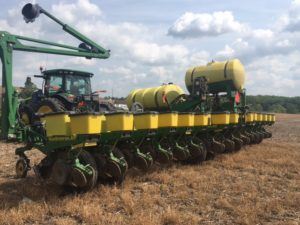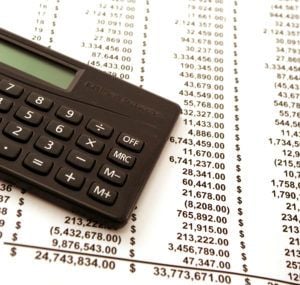Most buyers of farmland are farmers vs. investors
By Michele F. Mihaljevich
WEST LAFAYETTE, Ind. – Billionaires such as Jeff Bezos and Bill Gates have been in the news for purchasing farmland for investment purposes, but most buyers of farmland are farmers or local investors, according to those with knowledge of the industry.
About 80 percent of farmland around the country is purchased by farmers, said Todd H. Kuethe, Schrader Chair in Farmland Economics and associate professor of agricultural economics at Purdue University. “The typical farmland owner will own it for about 30 years. They plan to farm it now and will later rent it out. A lot of farmers view farm-land as their retirement plan.”
After farmers, the next biggest group of investors is high net worth individuals, he said.
Bezos, the founder of Amazon, owns about 420,000 acres of U.S. farmland, according to media reports. Gates, co-founder of Microsoft, has nearly 270,000 acres. The United States has more than 895 million acres of land in farms, the USDA has reported.
About 60 percent of farmland sales through Halderman Real Estate Services are to farmers, said Howard Halderman, the company’s president. Forty percent are to investors. Of that 40 percent, 38 percent want to own farmland because they grew up on a farm. Two percent are institutional buyers, such as endowments and pensions.
“ Most farmer buyers are looking to add to their overall operation,” he noted. “They look at it as more productive acres they can farm. Retirement isn’t their primary thought.
Most farmer buyers are looking to add to their overall operation,” he noted. “They look at it as more productive acres they can farm. Retirement isn’t their primary thought.
They may be buying it for the next generation to return to the farm. It gives future generations the opportunity to experience the wonderful lifestyle they’ve had. As the kids come back, you’re going to need more land. In reality, investors are the neighbor down the road – a farmer or local investor.”
Generally, farmers are purchasing about 70 percent of land sold by Schrader Real Estate and Auction Co., while investors buy 30 percent, said R.D. Schrader, president of the company. “It can depend on the dynamics,” he explained. “When farm income isn’t as strong, it gives investors a chance to get in there.
“The local market is typically the driving force. Some parts of the country have a higher ratio of investor interest. Some smaller investors may want to buy 40 acres, and big investment funds want to buy thousands of acres. Farmland is typically worth more to operators.”
Paul Pittman, executive chairman and CEO of Farmland Partners Inc., said the top buyers of farmland are the farmers themselves, followed by those with rural roots who aren’t farmers but who want to own farmland.
Farmers compete heavily for farmland because when a farm goes up for sale, it might be the first time it’s been on the market in 40-50 years, Pittman said. It also may never get sold again, he added.
“This is why farmers will always outbid institutional investors,” he explained. “If a farmer really wants it, we won’t be the buyer. Farmers will always be your top bidders. It’s the way it should be. It’s worth more to him than to us.”
Farmland is of interest to investors because it has a relatively stable set of returns, Kuethe said. There’s an appreciation of the asset value and it offers annual returns through renting or directly farming it themselves, he said. Investors look at farmland as a way to diversify their portfolios, Halderman said.
“They compare it to a fixed income investment like bonds,” he said. “It’s an inflation hedge. Farmland provides a greater return than the cost of ownership. It has a positive net cash flow. The rate of return is 2 ½, 3 percent.
“It has a zero vacancy rate. Other types of real estate, such as commercial, residential and industrial, have some kind of vacancy. The USDA says farmland has a 4-5 percent appreciation rate every year. It isn’t super volatile.”
Farmland is viewed as a safe investment, Schrader said. “It’s a hard asset. Some view the stock market as a place their money could disappear on them. Land has an incredible appreciation. The benefit of land for investors is they get a return on their investment.”
Investors are attracted to farmland because of the “absolute stability that comes from continued food demand and scarcity of the land,” Pittman said. “There’s no more supply. Farmland is an incredible long-term store of value. This is not a get-rich-quick asset. It’s about long-term savings. If you’re looking to get rich quick, don’t invest in farmland.”
Pittman’s company is a publicly-traded real estate investment trust (REIT). The Denver-based company has 185,700 acres in 19 states, including Illinois, Indiana, Iowa,

and Michigan.
As a REIT, the company is required to distribute at least 95 percent of profits or net income. Individual investors pay income tax on the distributions, he noted. Those at the corporate level don’t pay income tax. Investors purchase stock traded on the New York Stock Exchange. Those investors own a portion of the 350 farms the company has around the country.
Probably about 50-60 percent of the nation’s farmland is operated by someone other than the owner, Kuethe said. “For the last 40 years or so, that’s been the situation in the agricultural sector, though it’s not unique to agriculture. Small businesses will rent their spaces – a bakery doesn’t buy the building. If you farm land on a commercial scale – supporting one or more households – you may have half a dozen to a dozen different land-lords.”
Schrader said about all the farmers he knows rent some of their land. Rented land makes it easier for new or beginning farmers to get into agriculture, he added. “It’s tough for first-generation farmers to start if they have to own everything. It’s not feasible, it’s such a high cost for a startup. Being able to rent is a much better business model.”
The history of institutional investing in farmland goes back to the 1980s, Halderman said. There’s more interest from institutions today than ever before because farmland is an investable asset class for those groups, he said.
“There are more vehicles to make a purchase than ever before, which makes it easier to invest,” he pointed out. “It does ebb and flow with the market. There’s more interest today thanks to inflation and high commodity prices.”
When talking with potential institutional investors, Halderman tells them, “If you want to get into farmland, great. But don’t day trade agriculture. If you’re going to get into farmland, you need to be willing to be in it for 10 years. Farmland is a steady, good long-term return.”
For operators, the amount of farm income they have available helps to decide how aggressive they might be when purchasing land, Schrader said.
“In the 1980s, when times got really tough in the world for agriculture, if a neighbor didn’t want (the land), there might not be anyone who wanted it. Today, investors provide a floor in the market when there’s not a strong enough demand from operators.”
Institutional investing is about 2-3 percent of the market, though it is gradually growing, Pittman said.
“Farmland investing can be reduced to one single concept: fundamental global food demand continues to gradually increase. Every year we have a higher demand for food. At the same time, land available for farming per capita has decreased. (Farmland) is an unstoppable long-term asset class.”
